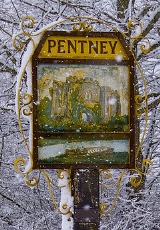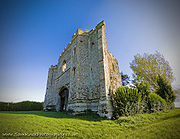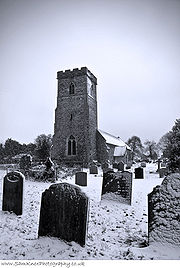
Pentney
Encyclopedia
Pentney is a village
and civil parish
in the English county of Norfolk
, located about 8 miles (12.9 km) south east of Kings Lynn placing it about halfway between Kings Lynn and Swaffham
on the A47 road
.
It covers an area of 10.39 km² (4 sq mi) and had a population of 387 in 184 households as of the 2001 census
.
For the purposes of local government, it falls within the district
of North Norfolk
. It is in the valley of the River Nar
, a tributary of the River Great Ouse
.
The age of the village is unknown, but it dates at least to the 3rd or 4th centuries CE, from which time there is evidence of a Romano-British local pottery industry.A Roman road and settlement in Pentney ran close to the river Nar The name suggests that Pentney was at one time an island: one theory for the etymology is Penta's / Penda's Island, from the Anglo-Saxon Pendan-ig, the ig being equivalent to Old Norse ey = island (Pentney is on drained waterlands).
 About a mile west of the village, on the north bank of the River Nar, is the gatehouse, all that remains of the Augustinian
About a mile west of the village, on the north bank of the River Nar, is the gatehouse, all that remains of the Augustinian
Pentney Priory
, also known as Priory of the Holy Trinity, St Mary and St Magdalene, established around 1130. It was founded by Robert De Vaux, one of the Norman nobles who came to England with William I
. on lands that had belonged to Hacon the Dane, evicted by William. De Vaux installed a number of Augustine Canons to come and settle at Pentney to pray for the souls of him and his family. It soon established itself, and continued for centuries, as a significant and prosperous presence in Pentney for its farming and teaching activities.
The gatehouse itself - "the finest in Norfolk and a smaller copy of that at Thornton Abbey
" - dates from the 14th century and is a three-storey multi-unit lodging built of flint rubble with Barnack stone dressing.
A number of members of aristocratic families are known to have been buried at the Priory: Maud, wife of William de Ros
; Petronilla de Nerford (died 1326) and John de Nerford (died 1328).
Pentney Priory became the centre of a religious and political controversy in the 1160s when Hugh Bigod, 1st Earl of Norfolk
took the opportunity during the anarchic reign of King Stephen
to seize its considerable lands, claiming the right under a weakness in the details of a property agreement between his father and Roger de Vaux. Geoffrey, the Prior of Pentney, took the case to the Pope, and when it finally was dealt with, in the reign of Henry II
, Bigod was excommunicated by the Pope, who imposed an interdict
on the earldom. This created a tension between Henry, who opposed the interdict, and the Bishops of London and Norwich, who with the support of Thomas Becket
were expected to enforce it.
In 1280, Archbishop John Peckham
conducted a stringent visitation
of the Priory as part of a crackdown on misconduct at religious institutions in the Norwich diocese. Pentney and its Canons were found without fault.
The Priory went in decline in the 15th century, and consolidated with Wormegay
priory in 1468.
Pentney Priory was finally closed during the Dissolution of the Monasteries
under Henry VIII
, who had the Priory shut down in February 1537, and its estate and properties sold to Thomas Manners
, the Earl of Rutland.
Stone from the Priory has been used in Abbey Farm and its outbuildings on the site. Many of the houses and outbuildings in Pentney also contain Barnack stone taken from the Abbey.
 Between the village and the Priory are the remains of a wayside cross; the cross having been broken off in historical times, only the plinth and pillar remain. A correspondent to Notes and Queries wrote of it: "We find the pedestal and shaft of what must have been, when perfect, a most handsome cross, it all seems in such perfect proportion. The shaft is remarkably slender, even for a wayside cross".
Between the village and the Priory are the remains of a wayside cross; the cross having been broken off in historical times, only the plinth and pillar remain. A correspondent to Notes and Queries wrote of it: "We find the pedestal and shaft of what must have been, when perfect, a most handsome cross, it all seems in such perfect proportion. The shaft is remarkably slender, even for a wayside cross".
 The church of St Mary Magdalene has stood on this site since Norman times, and was originally built as a small chapel with an apse
The church of St Mary Magdalene has stood on this site since Norman times, and was originally built as a small chapel with an apse
. It was doubled in length in the 13th or 14th century.
gravedigger, William King, found six silver Saxon brooches while digging a grave at the church. Not realising what they were, he handed them to the rector, who locked them in the vestry chest. Three years later the new rector, the Rev. John Wilson, recognised their significance, and they were subsequently identified by the British Museum
as 9th century silver disc brooches of national importance, made of delicately cut and engraved sheet silver.
An inquest declared the items as treasure trove
and the property of the Crown. Mr King was given the value of the brooches, £135,000. He donated £25,000 to Pentney church, and the brooches can now be viewed at the British Museum.
on the Lynn and Dereham Railway
. The line was opened in 1846-8, and closed in September 1968 as part of the Beeching Axe
.
Currently, the only remaining public transport links to the village are an infrequent bus service which operates in the morning only.
The River Nar is not navigable, but was temporarily made so in the 1750s. Authorised by an Act of 1751, the river was opened for barge traffic, with ten staunches constructed, from King's Lynn
to Narborough
, a little east of Pentney. River traffic ceased in 1884.
 When the quarry proposal was announced to the villagers in March 2008, a website was set up by local resident Sam Knox
When the quarry proposal was announced to the villagers in March 2008, a website was set up by local resident Sam Knox
with the aim of rallying worldwide support for the Pentney villagers and to bring the story to the attention of the national press http://www.lynnnews.co.uk/news/leave_poor_pentney_be_fry_1_518336. Within days, it had the support and endorsement of Stephen Fry
who lives less than a mile away from the village, and by mid April, the story was being reported in local newspapers, TV and radio news programmes, as well as national newspapers such as the Daily Telegraph.
By the start of May 2008, a group of seven villagers had collaborated with the Save Pentney website to form the Save Pentney Action Group (SPAG), whose objective was to represent the villagers in conducting research into the feasibility of operating the quarry within the village. It sent a dossier to Norfolk County Council, objecting to MIN93 in the strongest possible terms.
On September 7, 2009, Norfolk County Council published the list of sites which had been selected for the next stage in the consultation process. MIN93 had been dropped from the process, declared "Not Acceptable".
Village
A village is a clustered human settlement or community, larger than a hamlet with the population ranging from a few hundred to a few thousand , Though often located in rural areas, the term urban village is also applied to certain urban neighbourhoods, such as the West Village in Manhattan, New...
and civil parish
Civil parish
In England, a civil parish is a territorial designation and, where they are found, the lowest tier of local government below districts and counties...
in the English county of Norfolk
Norfolk
Norfolk is a low-lying county in the East of England. It has borders with Lincolnshire to the west, Cambridgeshire to the west and southwest and Suffolk to the south. Its northern and eastern boundaries are the North Sea coast and to the north-west the county is bordered by The Wash. The county...
, located about 8 miles (12.9 km) south east of Kings Lynn placing it about halfway between Kings Lynn and Swaffham
Swaffham
Swaffham is a market town and civil parish in the English county of Norfolk. The town is situated east of King's Lynn and west of Norwich.The civil parish has an area of and in the 2001 census had a population of 6,935 in 3,130 households...
on the A47 road
A47 road
The A47 is a trunk road in England originally linking Birmingham to Great Yarmouth. Most of the section between Birmingham and Nuneaton is now classified as the B4114.-Route:...
.
It covers an area of 10.39 km² (4 sq mi) and had a population of 387 in 184 households as of the 2001 census
United Kingdom Census 2001
A nationwide census, known as Census 2001, was conducted in the United Kingdom on Sunday, 29 April 2001. This was the 20th UK Census and recorded a resident population of 58,789,194....
.
For the purposes of local government, it falls within the district
Non-metropolitan district
Non-metropolitan districts, or colloquially shire districts, are a type of local government district in England. As created, they are sub-divisions of non-metropolitan counties in a so-called "two-tier" arrangement...
of North Norfolk
North Norfolk
North Norfolk is a local government district in Norfolk, United Kingdom. Its council is based in Cromer. The council headquarters can be found approximately out of the town of Cromer on the Holt Road.-History:...
. It is in the valley of the River Nar
River Nar
The River Nar is a river in England, and tributary of the River Great Ouse. It rises near Litcham in Norfolk and flows 15 miles west through Castle Acre and Narborough , joining the Ouse at King's Lynn. It has had a variety of alternative names, such as the Setch, the Sandringham, and Lynn Flu,...
, a tributary of the River Great Ouse
River Great Ouse
The Great Ouse is a river in the east of England. At long, it is the fourth-longest river in the United Kingdom. The river has been important for navigation, and for draining the low-lying region through which it flows. Its course has been modified several times, with the first recorded being in...
.
The age of the village is unknown, but it dates at least to the 3rd or 4th centuries CE, from which time there is evidence of a Romano-British local pottery industry.A Roman road and settlement in Pentney ran close to the river Nar The name suggests that Pentney was at one time an island: one theory for the etymology is Penta's / Penda's Island, from the Anglo-Saxon Pendan-ig, the ig being equivalent to Old Norse ey = island (Pentney is on drained waterlands).
Augustinian Priory

Augustinians
The term Augustinians, named after Saint Augustine of Hippo , applies to two separate and unrelated types of Catholic religious orders:...
Pentney Priory
Priory
A priory is a house of men or women under religious vows that is headed by a prior or prioress. Priories may be houses of mendicant friars or religious sisters , or monasteries of monks or nuns .The Benedictines and their offshoots , the Premonstratensians, and the...
, also known as Priory of the Holy Trinity, St Mary and St Magdalene, established around 1130. It was founded by Robert De Vaux, one of the Norman nobles who came to England with William I
William I of England
William I , also known as William the Conqueror , was the first Norman King of England from Christmas 1066 until his death. He was also Duke of Normandy from 3 July 1035 until his death, under the name William II...
. on lands that had belonged to Hacon the Dane, evicted by William. De Vaux installed a number of Augustine Canons to come and settle at Pentney to pray for the souls of him and his family. It soon established itself, and continued for centuries, as a significant and prosperous presence in Pentney for its farming and teaching activities.
The gatehouse itself - "the finest in Norfolk and a smaller copy of that at Thornton Abbey
Thornton Abbey
Thornton Abbey was founded as a priory in 1139 by William le Gros, the Earl of Yorkshire, and raised to the status of Abbey in 1148. It was a house for Augustinian or black canons. These priests lived a communal life under the Rule of St Augustine but also undertook pastoral duties outside of the...
" - dates from the 14th century and is a three-storey multi-unit lodging built of flint rubble with Barnack stone dressing.
A number of members of aristocratic families are known to have been buried at the Priory: Maud, wife of William de Ros
William de Ros, 2nd Baron de Ros
William de Ros, 2nd Baron de Ros of Helmsley was a claimant to the crown of Scotland. He was the son of Robert de Ros, 1st Baron de Ros....
; Petronilla de Nerford (died 1326) and John de Nerford (died 1328).
Pentney Priory became the centre of a religious and political controversy in the 1160s when Hugh Bigod, 1st Earl of Norfolk
Hugh Bigod, 1st Earl of Norfolk
Hugh Bigod, 1st Earl of Norfolk was born in Belvoir Castle, Leicestershire, England.He was the second son of Roger Bigod , Sheriff of Norfolk, who founded the Bigod name in England...
took the opportunity during the anarchic reign of King Stephen
Stephen of England
Stephen , often referred to as Stephen of Blois , was a grandson of William the Conqueror. He was King of England from 1135 to his death, and also the Count of Boulogne by right of his wife. Stephen's reign was marked by the Anarchy, a civil war with his cousin and rival, the Empress Matilda...
to seize its considerable lands, claiming the right under a weakness in the details of a property agreement between his father and Roger de Vaux. Geoffrey, the Prior of Pentney, took the case to the Pope, and when it finally was dealt with, in the reign of Henry II
Henry II of England
Henry II ruled as King of England , Count of Anjou, Count of Maine, Duke of Normandy, Duke of Aquitaine, Duke of Gascony, Count of Nantes, Lord of Ireland and, at various times, controlled parts of Wales, Scotland and western France. Henry, the great-grandson of William the Conqueror, was the...
, Bigod was excommunicated by the Pope, who imposed an interdict
Interdict
The term Interdict may refer to:* Court order enforcing or prohibiting a certain action* Injunction, such as a restraining order...
on the earldom. This created a tension between Henry, who opposed the interdict, and the Bishops of London and Norwich, who with the support of Thomas Becket
Thomas Becket
Thomas Becket was Archbishop of Canterbury from 1162 until his murder in 1170. He is venerated as a saint and martyr by both the Roman Catholic Church and the Anglican Communion...
were expected to enforce it.
In 1280, Archbishop John Peckham
John Peckham
John Peckham was Archbishop of Canterbury in the years 1279–1292. He was a native of Sussex who was educated at Lewes Priory and became a Franciscan friar about 1250. He studied at Paris under Bonaventure, where he later taught theology. From his teaching, he came into conflict with Thomas...
conducted a stringent visitation
Canonical Visitation
A canonical visitation is the act of an ecclesiastical superior who in the discharge of his office visits persons or places with a view of maintaining faith and discipline, and of correcting abuses by the application of proper remedies.-Catholic usage:...
of the Priory as part of a crackdown on misconduct at religious institutions in the Norwich diocese. Pentney and its Canons were found without fault.
The Priory went in decline in the 15th century, and consolidated with Wormegay
Wormegay
Wormegay is a civil parish in the English county of Norfolk. The village is situated some south of King's Lynn and west of Norwich.It covers an area of and had a population of 339 in 141 households as of the 2001 census....
priory in 1468.
Pentney Priory was finally closed during the Dissolution of the Monasteries
Dissolution of the Monasteries
The Dissolution of the Monasteries, sometimes referred to as the Suppression of the Monasteries, was the set of administrative and legal processes between 1536 and 1541 by which Henry VIII disbanded monasteries, priories, convents and friaries in England, Wales and Ireland; appropriated their...
under Henry VIII
Henry VIII of England
Henry VIII was King of England from 21 April 1509 until his death. He was Lord, and later King, of Ireland, as well as continuing the nominal claim by the English monarchs to the Kingdom of France...
, who had the Priory shut down in February 1537, and its estate and properties sold to Thomas Manners
Thomas Manners, 1st Earl of Rutland
Thomas Manners, 1st Earl of Rutland, 13th Baron de Ros of Helmsley was created an earl by King Henry VIII of England in 1525.-Family background:...
, the Earl of Rutland.
Stone from the Priory has been used in Abbey Farm and its outbuildings on the site. Many of the houses and outbuildings in Pentney also contain Barnack stone taken from the Abbey.
Wayside Cross

Pentney Church

Apse
In architecture, the apse is a semicircular recess covered with a hemispherical vault or semi-dome...
. It was doubled in length in the 13th or 14th century.
Pentney Treasure
In 1977, an East DerehamDereham
Dereham, also known as East Dereham, is a town and civil parish in the English county of Norfolk. It is situated on the A47 road, some 15 miles west of the city of Norwich and 25 miles east of King's Lynn. The civil parish has an area of and in the 2001 census had a population of...
gravedigger, William King, found six silver Saxon brooches while digging a grave at the church. Not realising what they were, he handed them to the rector, who locked them in the vestry chest. Three years later the new rector, the Rev. John Wilson, recognised their significance, and they were subsequently identified by the British Museum
British Museum
The British Museum is a museum of human history and culture in London. Its collections, which number more than seven million objects, are amongst the largest and most comprehensive in the world and originate from all continents, illustrating and documenting the story of human culture from its...
as 9th century silver disc brooches of national importance, made of delicately cut and engraved sheet silver.
An inquest declared the items as treasure trove
Treasure trove
A treasure trove may broadly be defined as an amount of money or coin, gold, silver, plate, or bullion found hidden underground or in places such as cellars or attics, where the treasure seems old enough for it to be presumed that the true owner is dead and the heirs undiscoverable...
and the property of the Crown. Mr King was given the value of the brooches, £135,000. He donated £25,000 to Pentney church, and the brooches can now be viewed at the British Museum.
Transport
Pentney was formerly served by the Narborough and Pentney railway stationNarborough and Pentney railway station
Narborough and Pentney railway station was a station in Norfolk, serving the villages of Narborough and Pentney. It was on the line between King's Lynn and Swaffham. It was closed as part of the Beeching Axe, and now exists as a private residence...
on the Lynn and Dereham Railway
Lynn and Dereham Railway
The Lynn and Dereham Railway was a standard gauge single track railway running between King's Lynn and Dereham in the English county of Norfolk...
. The line was opened in 1846-8, and closed in September 1968 as part of the Beeching Axe
Beeching Axe
The Beeching Axe or the Beeching Cuts are informal names for the British Government's attempt in the 1960s to reduce the cost of running British Railways, the nationalised railway system in the United Kingdom. The name is that of the main author of The Reshaping of British Railways, Dr Richard...
.
Currently, the only remaining public transport links to the village are an infrequent bus service which operates in the morning only.
The River Nar is not navigable, but was temporarily made so in the 1750s. Authorised by an Act of 1751, the river was opened for barge traffic, with ten staunches constructed, from King's Lynn
King's Lynn
King's Lynn is a sea port and market town in the ceremonial county of Norfolk in the East of England. It is situated north of London and west of Norwich. The population of the town is 42,800....
to Narborough
Narborough
-Places:*Narborough, Leicestershire*Narborough, Norfolk*Narborough, Northamptonshire, a historical name for Northborough in a small village near the city of Peterborough in the East of England....
, a little east of Pentney. River traffic ceased in 1884.
Pentney quarry campaign
In 2008-2009, Pentney villagers fought proposals to open a gravel quarry in the northern edge of the village on the land known as Church Farm, the scheme proposed as part of Norfolk County Council's mineral extraction consultation process. The villagers more or less unanimously objected to the quarry, designated MIN93, primarily on grounds of its proximity to, and even encroachment on, the village and habitable areas.
Sam Knox
Sam Knox is a photographer who supplies sports photography to local, national and international press agencies.Additionally, his photography appears on various websites.-Gallery:...
with the aim of rallying worldwide support for the Pentney villagers and to bring the story to the attention of the national press http://www.lynnnews.co.uk/news/leave_poor_pentney_be_fry_1_518336. Within days, it had the support and endorsement of Stephen Fry
Stephen Fry
Stephen John Fry is an English actor, screenwriter, author, playwright, journalist, poet, comedian, television presenter and film director, and a director of Norwich City Football Club. He first came to attention in the 1981 Cambridge Footlights Revue presentation "The Cellar Tapes", which also...
who lives less than a mile away from the village, and by mid April, the story was being reported in local newspapers, TV and radio news programmes, as well as national newspapers such as the Daily Telegraph.
By the start of May 2008, a group of seven villagers had collaborated with the Save Pentney website to form the Save Pentney Action Group (SPAG), whose objective was to represent the villagers in conducting research into the feasibility of operating the quarry within the village. It sent a dossier to Norfolk County Council, objecting to MIN93 in the strongest possible terms.
On September 7, 2009, Norfolk County Council published the list of sites which had been selected for the next stage in the consultation process. MIN93 had been dropped from the process, declared "Not Acceptable".

